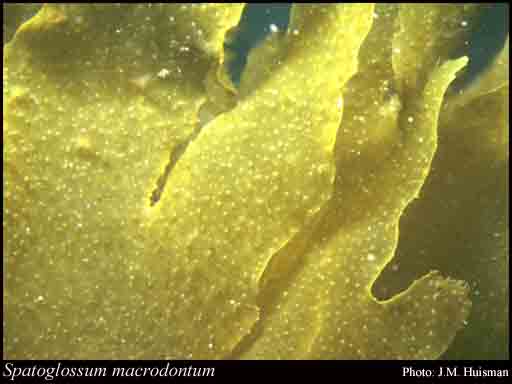- Reference
- Algern.Syst. 17:113-114 (1882)
- Conservation Code
- Not threatened
- Naturalised Status
- Native to Western Australia
- Name Status
- Current

Scientific Description
Habit and structure. Thallus olive-brown, attached by a matted rhizoidal holdfast, to 35 cm tall, complanate, subdichotomously or, more frequently, irregularly branched. Axes 5–40 mm wide, with spinous margins, lacking midribs and veins, 4–6 cells and 100–450 μm thick; cortical cells quadrangular in T.S., overlying larger irregularly aligned angular to ovoid medullary cells. Hair tufts densely scattered; basal cells embedded in the thallus. Reproductive structures embedded in the thallus. Sporangia angular in surface view, solitary or in small groups, producing 4 ovoid to spherical spores. Oogonia angular in surface view, solitary or in small groups, or in scattered sori. Antheridial sori whitish, scattered across the thallus.
Distribution. Recorded from eastern Australia, Lord Howe Island, Japan and the Hawaiian Islands. In N.W.A. known from Ningaloo to Broome.
Habitat. Epilithic in the intertidal and shallow subtidal.
[After Huisman & Phillips, Algae of Australia: Mar. Benthic Algae of North-western Australia, 1. Green and Brown Algae 215 (2015)]
Distribution
- IBRA Regions
- Carnarvon, Dampierland.
- IBRA Subregions
- Cape Range, Pindanland.
- IMCRA Regions
- Central West Coast, Kimberley, Ningaloo, Pilbara (nearshore), Pilbara (offshore).
- Local Government Areas (LGAs)
- Ashburton, Broome, Dandaragan, Derby-West Kimberley, Exmouth, Karratha, Port Hedland, Wyndham-East Kimberley.